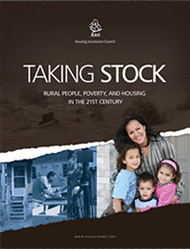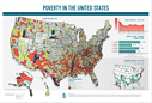
DATA SOURCES
U.S. Census Bureau's 2010 Census of Population and Housing I
The U.S. Census counts every resident in the United States. It is mandated by Article I, Section 2 of the Constitution and takes place every 10 years. The data collected by the decennial census determine the number of seats each state has in the U.S. House of Representatives and is also used to distribute billions in federal funds to local communities.
Approximately 74 percent of U.S. households returned their census forms by mail; the remaining households were counted by census workers walking neighborhoods throughout the United States. National and state population totals from the 2010 Census were released on December 21, 2010.
U.S. Census Bureau's American Community Survey (ACS) Five-Year Estimates (ACS) II
The American Community Survey (ACS) is a nationwide survey designed to provide communities with reliable and timely demographic, social, economic, and housing data every year. The U.S. Census Bureau presents data from the ACS in the form of both single-year and multiyear estimates. These estimates are fundamentally different from data presented through the decennial census or its predecessor, the decennial census "long form."
Every 10 years since 1790, Congress has authorized funds to conduct a national census of the U.S. population. The decennial census is required by the U.S. Constitution. Recent censuses have consisted of a "short form," which included basic questions about age, sex, race, Hispanic origin, household relationship, and owner/renter status, and a "long form." The long form was used at only a sample of households and included not only the basic questions on the short form but also detailed questions about social, economic, and housing characteristics. The questions on the long form supplied data and information for a range of programs affecting education, veterans, employment, housing and community development, public health care, commuting, services for the elderly and disabled, and assistance programs for low-income families and children. About $300 billion in federal program funds are distributed each year based, in whole or in part, on these data.
In order to deliver more timely information for all the geographic areas served by the decennial long form, the Census Bureau designed the ACS as a sample survey using a continuous measurement approach to data collection. A sample of 3 million addresses is drawn from the Census Bureau's master address file each year. The U.S. Census Bureau, under the authority of Title 13, U.S. Code, Sections 141 and 193, conducts the American Community Survey. Title 13 also requires that the Census Bureau use this information only for statistical purposes.
ACS survey questionnaires are sent to approximately 250,000 addresses across the country every month. Addresses from which a questionnaire is not returned by mail are followed-up, first in an attempt to obtain the information by telephone, and then, for a sample of nonresponding households, in person by a Census Bureau field interviewer.
Based on responses from the series of 12 independent monthly samples each calendar year, the ACS provides estimates of demographic, housing, social, and economic characteristics for all states, as well as for cities, counties, metropolitan areas, and population groups of 65,000 or more. These estimates, based on a full year's worth of collected ACS data, are called "1-year estimates." For less populated areas, such as rural villages and towns, 3 or 5 years of ACS data are accumulated to produce statistically reliable estimates of population and housing characteristics. Estimates for areas with populations of 20,000 or more are based on data collected over 3 years ("3-year estimates").
For rural areas, urban neighborhoods, census tracts, block groups, and population groups of fewer than 20,000 people, it takes 5 years to accumulate enough survey data to achieve data estimates with statistical reliability that is similar to that of the Census 2000 long-form sample survey. These "5-year estimates," are published for areas with small populations each year.
A detailed description of ACS data collection methodology and the survey's sample design may be found at: http://www.census.gov/acs/www/SBasics/desgn_meth.htm.
For more information on data and methodology in the American Community Survey (ACS) please consult the Census Bureau Documentation:
- http://www.census.gov/acs/www/Downloads/handbooks/ACSResearch.pdf
- http://www.census.gov/acs/www/Downloads/handbooks/ACSRuralAreaHandbook.pdf
FFIEC 2012 Home Mortgage Disclosure Act Data III
The Home Mortgage Disclosure Act (HMDA) was enacted in 1975 and is implemented by the Federal Reserve Board's Regulation C. This regulation applies to certain financial institutions, including banks, savings associations, credit unions, and other mortgage lending institutions. In 2013, there were approximately 18.7 million loan records for calendar year (CY) 2012 reported by 7,400 financial institutions.
Using the loan data submitted by these financial institutions, the Federal Financial Institutions Examination Council (FFIEC) creates aggregate and disclosure reports for each metropolitan area (MA) that are available to the public at central data depositories located in each MA.
While HMDA data are critical resource to understanding lending trends, the limitations of these data in rural areas must be acknowledged. Only those depository institutions with assets of $41 million or more operating a home or branch office in a metropolitan area were required to report HMDA data in 2012. Consequently, an undetermined number of rural lending data are unavailable, as many small, rural financial institutions are not required to report lending information. Despite these limitations, HMDA provides the best available information on rural lending. For detailed information about FFIEC Home Mortgage Disclosure Act data used in this database please consult, Home Mortgage Disclosure Act: About Data.
ENDNOTES
- * I Excerpted from, What is the Census?, http://2010.census.gov/2010census/about/
-
* II
Excerpted from U.S. Census Bureau.
A Compass for Understanding and Using American Community Survey Data: What Researchers Need to Know. U.S. Department of Commerce. Washington DC, May 2009.
http://www.census.gov/acs/www/Downloads/handbooks/ACSResearch.pdf -
* III
Excerpted from, Home Mortgage Disclosure Act: About the Data.
http://www.ffiec.gov/hmda/about.htm
About the Data
For a detailed analysis
of rural housing conditions download
HAC'S TAKING STOCK Report & Maps

Download Entire Report
Download By Section
National ConditionsRegional Analysis Appendices
Download Maps:
 Poverty in the United States
Poverty in the United States